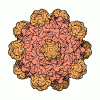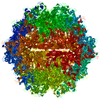[English] 日本語
 Yorodumi
Yorodumi- PDB-7thr: Cryo-electron microscopy of Adeno-associated virus serotype 4 at 2.2 A -
+ Open data
Open data
- Basic information
Basic information
| Entry | Database: PDB / ID: 7thr | ||||||
|---|---|---|---|---|---|---|---|
| Title | Cryo-electron microscopy of Adeno-associated virus serotype 4 at 2.2 A | ||||||
 Components Components | Capsid | ||||||
 Keywords Keywords | VIRUS LIKE PARTICLE / AAV4 / adeno-associated virus / serotype 4 | ||||||
| Function / homology | Phospholipase A2-like domain / Phospholipase A2-like domain / Parvovirus coat protein VP2 / Parvovirus coat protein VP1/VP2 / Parvovirus coat protein VP1/VP2 / Capsid/spike protein, ssDNA virus / T=1 icosahedral viral capsid / structural molecule activity / Capsid Function and homology information Function and homology information | ||||||
| Biological species |  Adeno-associated virus - 4 Adeno-associated virus - 4 | ||||||
| Method | ELECTRON MICROSCOPY / single particle reconstruction / cryo EM / Resolution: 2.21 Å | ||||||
 Authors Authors | Zane, G.M. / Silveria, M.A. / Meyer, N.L. / White, T.A. / Chapman, M.S. | ||||||
| Funding support |  United States, 1items United States, 1items
| ||||||
 Citation Citation |  Journal: Acta Crystallogr D Struct Biol / Year: 2023 Journal: Acta Crystallogr D Struct Biol / Year: 2023Title: Cryo-EM structure of adeno-associated virus 4 at 2.2 Å resolution. Authors: Grant Zane / Mark Silveria / Nancy Meyer / Tommi White / Rui Duan / Xiaoqin Zou / Michael Chapman /  Abstract: Adeno-associated virus (AAV) is the vector of choice for several approved gene-therapy treatments and is the basis for many ongoing clinical trials. Various strains of AAV exist (referred to as ...Adeno-associated virus (AAV) is the vector of choice for several approved gene-therapy treatments and is the basis for many ongoing clinical trials. Various strains of AAV exist (referred to as serotypes), each with their own transfection characteristics. Here, a high-resolution cryo-electron microscopy structure (2.2 Å) of AAV serotype 4 (AAV4) is presented. The receptor responsible for transduction of the AAV4 clade of AAV viruses (including AAV11, AAV12 and AAVrh32.33) is unknown. Other AAVs interact with the same cell receptor, adeno-associated virus receptor (AAVR), in one of two different ways. AAV5-like viruses interact exclusively with the polycystic kidney disease-like 1 (PKD1) domain of AAVR, while most other AAVs interact primarily with the PKD2 domain. A comparison of the present AAV4 structure with prior corresponding structures of AAV5, AAV2 and AAV1 in complex with AAVR provides a foundation for understanding why the AAV4-like clade is unable to interact with either PKD1 or PKD2 of AAVR. The conformation of the AAV4 capsid in variable regions I, III, IV and V on the viral surface appears to be sufficiently different from AAV2 to ablate binding with PKD2. Differences between AAV4 and AAV5 in variable region VII appear to be sufficient to exclude binding with PKD1. | ||||||
| History |
|
- Structure visualization
Structure visualization
| Structure viewer | Molecule:  Molmil Molmil Jmol/JSmol Jmol/JSmol |
|---|
- Downloads & links
Downloads & links
- Download
Download
| PDBx/mmCIF format |  7thr.cif.gz 7thr.cif.gz | 125.4 KB | Display |  PDBx/mmCIF format PDBx/mmCIF format |
|---|---|---|---|---|
| PDB format |  pdb7thr.ent.gz pdb7thr.ent.gz | Display |  PDB format PDB format | |
| PDBx/mmJSON format |  7thr.json.gz 7thr.json.gz | Tree view |  PDBx/mmJSON format PDBx/mmJSON format | |
| Others |  Other downloads Other downloads |
-Validation report
| Summary document |  7thr_validation.pdf.gz 7thr_validation.pdf.gz | 1.3 MB | Display |  wwPDB validaton report wwPDB validaton report |
|---|---|---|---|---|
| Full document |  7thr_full_validation.pdf.gz 7thr_full_validation.pdf.gz | 1.3 MB | Display | |
| Data in XML |  7thr_validation.xml.gz 7thr_validation.xml.gz | 41.9 KB | Display | |
| Data in CIF |  7thr_validation.cif.gz 7thr_validation.cif.gz | 60 KB | Display | |
| Arichive directory |  https://data.pdbj.org/pub/pdb/validation_reports/th/7thr https://data.pdbj.org/pub/pdb/validation_reports/th/7thr ftp://data.pdbj.org/pub/pdb/validation_reports/th/7thr ftp://data.pdbj.org/pub/pdb/validation_reports/th/7thr | HTTPS FTP |
-Related structure data
| Related structure data |  25903MC M: map data used to model this data C: citing same article ( |
|---|---|
| Similar structure data | Similarity search - Function & homology  F&H Search F&H Search |
- Links
Links
- Assembly
Assembly
| Deposited unit | 
|
|---|---|
| 1 | x 60
|
| 2 |
|
| 3 | x 5
|
| 4 | x 6
|
| 5 | 
|
| Symmetry | Point symmetry: (Schoenflies symbol: I (icosahedral)) |
- Components
Components
| #1: Protein | Mass: 80688.023 Da / Num. of mol.: 1 / Mutation: M1T Source method: isolated from a genetically manipulated source Details: VP1 sequence of AAV4 / Source: (gene. exp.)  Adeno-associated virus - 4 / Plasmid: pFastBac-LIC(4A) / Details (production host): AmpR / Cell line (production host): Sf9 / Production host: Adeno-associated virus - 4 / Plasmid: pFastBac-LIC(4A) / Details (production host): AmpR / Cell line (production host): Sf9 / Production host:  | ||||
|---|---|---|---|---|---|
| #2: Chemical | | #3: Water | ChemComp-HOH / | Has ligand of interest | N | |
-Experimental details
-Experiment
| Experiment | Method: ELECTRON MICROSCOPY |
|---|---|
| EM experiment | Aggregation state: PARTICLE / 3D reconstruction method: single particle reconstruction |
- Sample preparation
Sample preparation
| Component | Name: Adeno-associated virus / Type: VIRUS / Entity ID: #1 / Source: RECOMBINANT | |||||||||||||||
|---|---|---|---|---|---|---|---|---|---|---|---|---|---|---|---|---|
| Molecular weight | Value: 3.746 MDa / Experimental value: NO | |||||||||||||||
| Source (natural) | Organism:   Adeno-associated virus / Strain: Serotype 4 Adeno-associated virus / Strain: Serotype 4 | |||||||||||||||
| Source (recombinant) | Organism:  | |||||||||||||||
| Details of virus | Empty: YES / Enveloped: NO / Isolate: SEROTYPE / Type: VIRUS-LIKE PARTICLE | |||||||||||||||
| Natural host | Organism: Homo sapiens | |||||||||||||||
| Virus shell | Name: Capsid / Diameter: 250 nm / Triangulation number (T number): 1 | |||||||||||||||
| Buffer solution | pH: 7.4 | |||||||||||||||
| Buffer component |
| |||||||||||||||
| Specimen | Conc.: 0.33 mg/ml / Embedding applied: NO / Shadowing applied: NO / Staining applied: NO / Vitrification applied: YES Details: The sample was isolated by multiple rounds of cesium chloride density centrifugation and dialyzed into a HEPES-buffered, sodium chloride solution (see Meyer et al., 2019 Bioprotocols paper). | |||||||||||||||
| Specimen support | Grid material: COPPER / Grid mesh size: 400 divisions/in. / Grid type: PELCO Ultrathin Carbon with Lacey Carbon | |||||||||||||||
| Vitrification | Instrument: FEI VITROBOT MARK IV / Cryogen name: ETHANE / Humidity: 100 % / Chamber temperature: 298 K / Details: blot force: 4 time: 2 s |
- Electron microscopy imaging
Electron microscopy imaging
| Experimental equipment |  Model: Titan Krios / Image courtesy: FEI Company |
|---|---|
| Microscopy | Model: FEI TITAN KRIOS |
| Electron gun | Electron source:  FIELD EMISSION GUN / Accelerating voltage: 300 kV / Illumination mode: FLOOD BEAM FIELD EMISSION GUN / Accelerating voltage: 300 kV / Illumination mode: FLOOD BEAM |
| Electron lens | Mode: BRIGHT FIELD / Nominal magnification: 16500 X / Nominal defocus max: 1800 nm / Nominal defocus min: 600 nm / C2 aperture diameter: 50 µm |
| Image recording | Average exposure time: 1.4 sec. / Electron dose: 48 e/Å2 / Film or detector model: GATAN K3 BIOQUANTUM (6k x 4k) / Num. of grids imaged: 1 / Num. of real images: 4809 |
| EM imaging optics | Energyfilter name: GIF Bioquantum / Energyfilter slit width: 20 eV |
- Processing
Processing
| EM software |
| |||||||||||||||||||||||||||||||||||||||||||||
|---|---|---|---|---|---|---|---|---|---|---|---|---|---|---|---|---|---|---|---|---|---|---|---|---|---|---|---|---|---|---|---|---|---|---|---|---|---|---|---|---|---|---|---|---|---|---|
| CTF correction | Type: PHASE FLIPPING ONLY | |||||||||||||||||||||||||||||||||||||||||||||
| Particle selection | Num. of particles selected: 75226 | |||||||||||||||||||||||||||||||||||||||||||||
| Symmetry | Point symmetry: I (icosahedral) | |||||||||||||||||||||||||||||||||||||||||||||
| 3D reconstruction | Resolution: 2.21 Å / Resolution method: FSC 0.143 CUT-OFF / Num. of particles: 75226 / Algorithm: FOURIER SPACE / Num. of class averages: 1 / Symmetry type: POINT | |||||||||||||||||||||||||||||||||||||||||||||
| Atomic model building | Details: Link to CNS_RSRef software: https://chapman.missouri.edu/software/ | |||||||||||||||||||||||||||||||||||||||||||||
| Atomic model building | PDB-ID: 2G8G Pdb chain-ID: A / Accession code: 2G8G / Pdb chain residue range: 211-734 / Source name: PDB / Type: experimental model |
 Movie
Movie Controller
Controller


 PDBj
PDBj






